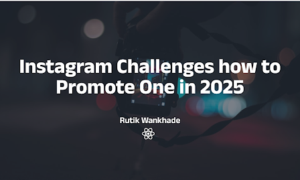Is your marketing campaign not getting your desired results? Here are some reasons why it may not work and what you can do to make it more effective.
Marketing can be a potent tool to grow your business. When done right, it can help you accelerate your business growth and boost your revenue. On the flip side, any miscalculated business decisions could cost you money.
You may have the best idea to communicate your business mission and values. But that doesn’t guarantee that your marketing campaign will succeed.
Maybe your campaign fails to resonate with the target audience or isn’t interesting enough to hold their attention — the reasons for failure could be many.
If you’re struggling to get desirable results from your campaign, you need to assess what you are doing wrong. In this article, I’ll discuss some common problem areas that might hurt your marketing strategy.
Why some businesses fail at marketing
Did you know that 14% of small businesses fail because of poor marketing? It’s sad. But why isn’t their marketing strategy yielding results?
Here, I’ll take a look at some of the common reasons why businesses fail at marketing and even check out some examples of failed marketing campaigns.
1. Lack of clear goals
Shooting without an aim — that’s what campaigns without clear goals are like. If you want your campaign to succeed, you need to know at the onset what you want to achieve from the campaign.
Your goals set the tone for the success of your overall campaign. And not just any loosely defined goals. It’s essential to setting business goals – it should have time-bound, verifiable, and realistic goals.
Many marketers fail to make a distinction between wishes and goals. Goals are more specific in nature.
Let’s understand this with an example.
Statement 1: I want to increase my revenue.
Statement 2: I want to boost my revenue 3x in 2 years.
While the first statement is merely a wish without any sense of urgency, the second one can be considered a solid, realistic goal.
It defines the time period as the growth rate clearly. Having a realistic and clear goal can help you optimize your resources and plan in a better way.
2. Not knowing their target audience well
For your email marketing campaigns to resonate with your targeted audience, you need to know their preferences. From how they lead their lives to the values that are important to them, you need to know it all. It’s a prerequisite to boosting your customer experience and satisfaction.
Without this knowledge, you can make a marketing blunder that may not strike their sensibilities.
That’s what happened with the launch of the iPhone 6. When Apple automatically downloaded U2’s new album onto the libraries of all iTunes users, it was not well-received.
While Apple thought their move to provide free music would be appreciated, the users found the move very imposing. Users criticized the move and called it an invasion of privacy.

Image Credit: SocialNewsDaily
What’s more, it was difficult to remove the album from the users’ accounts. After a week of scathing user comments, Apple released a tool so that users could delete the album quickly.
To avoid such a scenario, it’s essential to learn what your target audience values the most. Before launching your campaign, create buyer personas based on audience research. Reach out to your target audience, send them surveys, and conduct interviews.
You could also leverage social media analytics tools like Buffer, HootSuite, and others to understand audience preferences.
3. Using the wrong marketing channels
A big part of knowing your target audience is also analyzing their online behavior. Which social media channel are they most active on? When? These are some of the questions that you need to find answers to.
For instance, if your audience is primarily gamers, they are likely to be active on Twitch and YouTube. In such a case, running a campaign on Twitter may be a bit counter-productive or might not give you effective results.
Invest some time in learning more about your audience’s social media habits. For this, you can use social media monitoring tools to listen in on audience conversations on multiple platforms.
Compare the engagement rate and activity on each platform to identify the best marketing channel for your brand.
4. Unfocused messaging
Your campaign needs to appeal to the sensibilities of your audience. A good marketing campaign can address their pain points and win their confidence. If your message is not focused and targeted toward your audience, your campaign is going to fall flat.
Dove had the face of ire of social media users when their Instagram social media ad messaging sent out the wrong signals. The ad showed an African woman removing her shirt. The third panel shows a white woman after the short is removed.

Image Credit: CreativeWorksMarketing
While the company said they were trying to showcase the diversity of beauty, online users called them out for promoting racism.
To avoid this mistake, make sure your messaging is sensitive to people from diverse backgrounds. It helps to take the opinion of people from different ethnicities, especially if your campaign touches upon a sensitive topic.
Before finalizing an ad, get it reviewed multiple times and assess whether it is appropriate and in sync with your brand values. At any cost, you don’t want to publish something that may come across as tone-deaf.
5. Blindly copying other brands
It’s good to take inspiration from other successful marketing campaigns that are carried out by various marketing experts like Neil Patel. But blindly copying them can do more harm than good.
Big brands have a huge budgets and big teams to execute fancy projects. Without the same, you may not be able to create a similar campaign and get similar results.
What’s more, you may know that something is working for your competitor. They are getting likes, leads, and more sales because of a marketing campaign. But if you can’t pinpoint why the campaign is successful, it’s pointless.
Instead of blindly copying someone’s strategy, analyze why it worked. Then change it up based on your target audience, budget, goals, and industry.
6. Not highlighting your USP well
Your marketing campaigns provide you with the chance to tell your audience why your brand is better than the others. After watching your ad, they should be able to clearly tell what it is that you are doing differently.
Here is an example of a Facebook ad that highlights the product’s USP in a succinct manner. In just one line, it tells the reader the benefits they can get by buying the Square card reader.

Image via Falcon
7. Not testing and optimizing social media campaigns
Your job doesn’t end when a social media marketing campaign goes live. That’s only half the job done. Once it has gone live, you need to gauge the reaction of your target audience. Listen in on their online conversations and try to gauge the overall sentiment.
Not getting the kind of response you expected? No problem, identify the issues and find gaps to fill in. Maybe a tagline isn’t strong enough or the color scheme is off. Whatever isn’t working well, fix it.
Run multiple A/B tests for your social media campaigns to find what works and what doesn’t. Based on the results, optimize your campaigns to get better results. Keep in mind that adaptation is the key to creating a winning marketing campaign.
Summing up
If your marketing strategy isn’t getting the kind of response you were expecting, it’s time to assess your approach. You need to pay more attention to goal setting, clear messaging, and audience analysis.
While it’s great to look up to big brands for inspiration, don’t copy their strategies blindly. Instead, rethink them to suit your industry, target audience, and budget. In addition to this, make sure that you test and optimize your campaigns to get the best results.



































